Home Affordability Calculator
How much house can I afford?
When you're buying a home, mortgage lenders don't look just at your income, assets, and the down payment you have. They look at all of your liabilities and obligations as well, including auto loans, credit card debt, child support, potential property taxes and insurance, and your overall credit rating. Use our new house calculator to determine how much of a mortgage you may be able to obtain.
Definitions
- Current combined annual incomeThe gross annual income of you and your spouse (if applicable).
- Monthly child support paymentsThe monthly amount paid for child support.
- Monthly auto paymentsThe total monthly amount paid for automobile loans.
- Monthly credit card paymentsThe total monthly amount paid toward credit cards.
- Monthly association feesThe total monthly amount for association fees.
- Other monthly obligations <br><em>(not including current mortgage payment)</em>Any other monthly obigations.
- Annual interest rate on new mortgageThe interest rate for this home mortgage loan.
- Term of new mortgage The number of years you wish to finance this home mortgage loan.
- Funds available for a down paymentThe amount of cash you have available to use as a down payment.
- Estimated annual property taxesThe annual amount you expect to pay for property taxes.
- Estimated annual homeowner's insuranceThe annual amount you expect to pay for hazard/homeowner's insurance.
- Front-end ratioAlso known as the housing ratio, lenders use this ratio along with the back-end ratio to determine the maximum loan amount. Housing ratio equals combined (principal + interest + taxes + insurance) monthly mortgage payment divided by your gross monthly income. For example, a combined monthly mortgage payment of $1,200 divided by gross monthly income of $4,500 equals a housing ratio of 27%. Use a front-end ratio of 28% for conservative results and as high as 36% for aggressive results (usually requires a excellent credit and a higher down payment).
- Back-end ratioAlso known as the debt ratio, lenders use this ratio along with the front-end ratio to determine the maximum loan amount. Debt ratio equals your combined monthly mortgage payment plus any other monthly debt obligations such as credit cards and alimony divided by your gross monthly income. Use a front-end ratio of 33% for conservative results and as high as 42% for aggressive results (usually requires a excellent credit and a higher down payment).
This information may help you analyze your financial needs. It is based on information and assumptions provided by you regarding your goals, expectations and financial situation. The calculations do not infer that the company assumes any fiduciary duties. The calculations provided should not be construed as financial, legal or tax advice. In addition, such information should not be relied upon as the only source of information. This information is supplied from sources we believe to be reliable but we cannot guarantee its accuracy. Hypothetical illustrations may provide historical or current performance information. Past performance does not guarantee nor indicate future results.






